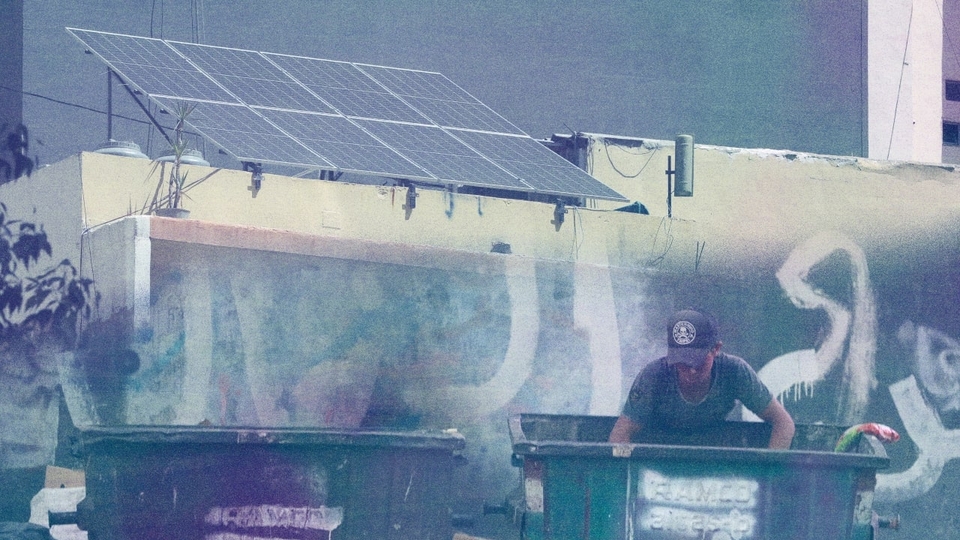Privatizing the Sun: The Dark Side of Lebanon’s “Solar Revolution”
After 15 years of working as an electrician, doing mostly home repairs, Wassim Osman was swept up in solar energy installations last year. At first, longtime clients and neighbors in Ghobeiry were contacting him to install solar panels and batteries they had bought. Then, others started asking him to also provide the material himself. Soon, the 39-year-old father of two was picking up installation jobs from companies and barely keeping up with the orders. “Solar energy is a gold mine right now,” he says, growing animated as he searches for the right word. “It's a boom, a bonanza. You should talk to the blacksmiths, they’re in even higher demand!” referring to the iron work critical for securing panels. The conversation turns to what it takes to maintain solar panels in good shape. “Funny you should ask,” he says, without missing a beat. “I am considering opening a business to do just that: cleaning solar panels.”
A little further south, on the airport road, Fouad Ismail runs a furniture company that has been in the family for generations. To source his inventory, he visits expos, mostly in China — because “if you do business with the Chinese once, you won’t do business with anyone else” — places orders with Chinese companies, and then picks up the large containers at the Beirut port. Before the solar boom, Ismail’s containers would bring in an assortment of home furnishings. But for over a year now, his containers have transported only solar panels and batteries. Fourteen containers to be exact, each carrying 620 panels — enough to power between 1,000 and 2,500 households. “Nobody was buying furniture, so I got in on it early,” he says. “By now, trust me, there is more solar product on the market than demand. The market is saturated.”
Everybody in Lebanon seems to know somebody who has reinvented themselves overnight to make a living (and beyond) from the solar business. An energy researcher jokingly recounts how his own father bought panels, without consulting him, from a medical doctor-turned-importer of solar kits. Once a niche environmentalist investment, solar panels have become part of the landscape, cluttering roofs, balconies, windows and even Beirut’s already crowded sidewalks.
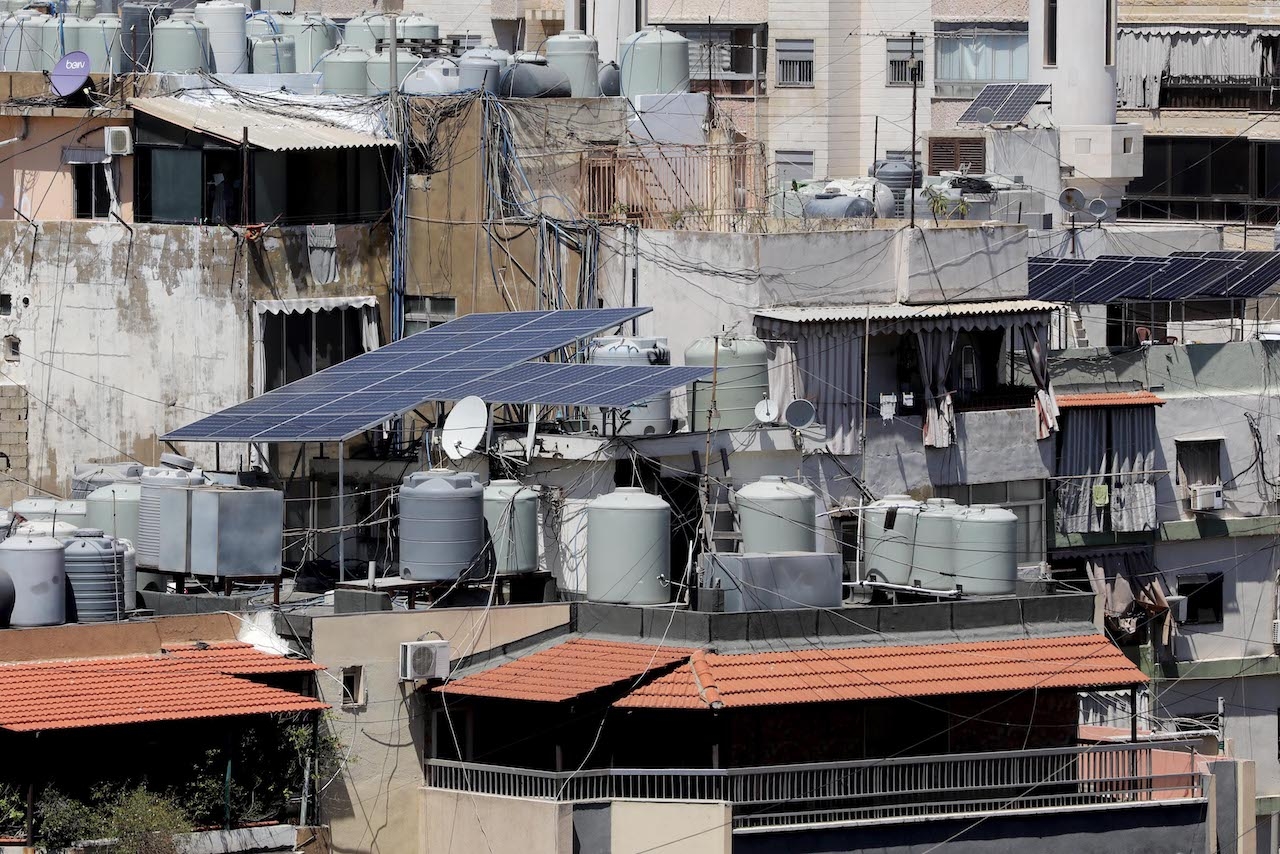
Just about every inch of rooftop in the capital has been filled, as solar panels join satellite dishes, wiring, private generators, and water tanks. Sometimes the only way to fit panels is to install them on chassis atop water tanks. Msaytbeh, Beirut, Lebanon. August 25, 2022. (Marwan Tahtah/The Public Source)
Lebanon is living through a “solar revolution,” we keep hearing in the media and webinars. Yet revolutions, by definition, are collective actions. Lebanon’s rush to solar is anything but. Instead, it is unfolding as a hyper-individualized, privatized free-for-all shopping spree. “Sometimes it feels like people are installing solar for their nafsiyye [psyche],” says energy expert Jessica Obeid. “The comfort of having solar because others have it, the comfort of not being left behind.” The sun has become the hottest consumer product in what anthropologist Ghassan Hage describes as Lebanon’s laissez-tout-faire economy — laissez-faire capitalism bereft of any government regulation.
Of course, moving to renewable energy is positive. For climate change mitigation and reducing air pollution, using solar power instead of fossil fuels is a “no-brainer,” as energy policy researcher Marc Ayoub puts it. Emissions from the ubiquitous diesel generators contain more than 40 toxic air contaminants, including many airborne carcinogens. By contrast, once they are produced, solar systems do not emit toxic gas emissions or greenhouse gasses. Their production, like that of any industrial product, does involve environmental costs. But the carbon footprint is still much greener than natural gas and coal (13 and 18 times, respectively, according to one study). Sunny Lebanon is also a good candidate for this type of renewable energy. Up to 34 percent of Beirut’s electricity demand could be covered by rooftop solar energy production alone, says the International Renewable Energy Agency (IRENA).
Lebanon is living through a “solar revolution,” we keep hearing in the media and webinars. Yet revolutions, by definition, are collective actions. Lebanon’s rush to solar is anything but.
Yet energy transitions are not simply about reducing carbon emissions; they carry other environmental, social, and economic impacts. Unregulated, privatized, and atomized, Lebanon’s move to solar is leaving behind all those who cannot afford to install the new technology, further consolidating electricity as a private commodity that only certain classes can afford. It is also creating a looming toxic waste crisis that will harm ecosystems and public health generally — but will fall disproportionately on the people who work in waste. “The individualized, chaotic approach is not sustainable,” says Ayoub. “This is not how to do an energy transition.”
Who Owns the Sun?
Layla is one of the people who cannot afford to buy the sun. We meet her sitting outside her small store along a strip of small businesses in the center of the village of Rahbe in Akkar. It’s around 7 p.m. and most stores have already shut down; those that remain open are almost pitch black inside. Rahbe had a total blackout in the first week of October. Before that, residents had been getting six hours of electricity per day — only two of them during business hours — from a subscription to diesel generators.
Layla, who prefers to identify herself only by her first name, pays L.L. 1-1.5 million a month in generator fees. (That’s $26-38 in today’s black market rate, but $670 -1,000 on the official exchange rate.) We ask if she has contemplated installing solar panels. “If you’re well off, and you have the ability to get solar energy, then sure,” she says. “But you know that the situation is very difficult now. Very few are able to afford it.”
In Rahbe, as in many towns and cities across Lebanon, the lack of electricity is harming people’s livelihoods and even driving them to leave home. Najla Fehmi is accustomed to working 8-hour days in her dental practice. But with only two hours of electricity, after she is done prepping and sterilizing the equipment, she can treat only one patient a day. “I’ve been mainly taking emergency cases, seeing people who are in pain, but I warn my patients that we might not be able to complete their procedure,” she says.
Fehmi cannot install a solar system because there isn’t enough space even for the batteries (her office is only 60 square meters). “None of my neighbors have solar panels,” she says. Many of them left the village, she adds, “because there’s neither a generator, nor can they install panels.”
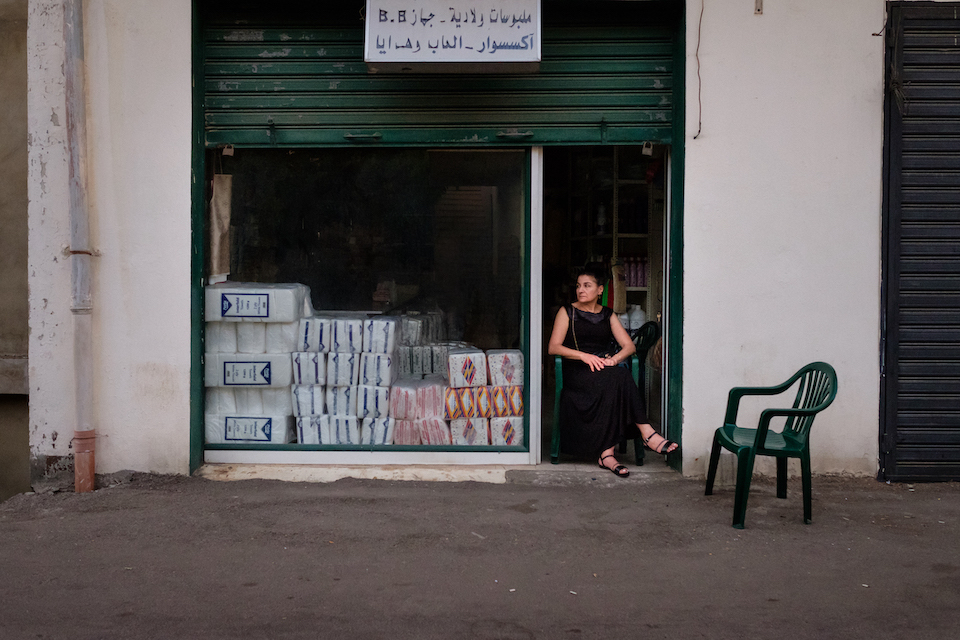
Layla, a shop owner in Rahbe, Akkar sits in front of her pitch-black store, along a strip of small businesses in the village center. The shop operates on two hours of electricity per day, provided by a private generator. Akkar, Lebanon. September 30, 2022. (Rita Kabalan/The Public Source)
At $0.057 per kilowatt hour, solar is the cheapest way of procuring energy for a household in Lebanon — only an eighth of the price of diesel-based power generation, which spiked when the government removed fuel subsidies last fall and made electricity unaffordable for many families. But to install solar systems, families need start-up capital in US dollars in cash — a pipe dream for vulnerable populations amid currency devaluation. Good systems, engineers tell us, start around $5,000.
No subsidies and only a few loan programs exist for solar installations, and it is unclear how many loans have been disbursed. Banque de l’Habitat’s “solar energy loan” requires an applicant to hold Lebanese nationality, be a homeowner, and pay them back within five years at an interest rate of five percent. The bank says it has received 10,000 applications but processed “only a few loans,” blaming the bureaucratic paralysis in government institutions. It has stopped accepting new applications until further notice.
Unregulated, privatized, and atomized, Lebanon’s move to solar is leaving behind all those who cannot afford to install the new technology, further consolidating electricity as a private commodity that only certain classes can afford.
When we ask Layla if she’s heard of loan programs, she scoffs. “Loans?” she says, with quiet, angry despair. “How would we be able to pay back these loans? Are we supposed to take a second mortgage on the house?”
Beyond the obvious binary inequity — whether one can or cannot install a solar system — are more subtle inequities that arise in technically complex and poorly regulated markets that turn energy into a decidedly private concern. In Lebanon, as in other countries going through an unregulated solar boom, households with lower incomes end up ultimately paying more for less reliable and shorter-lived, sub-standard installations.
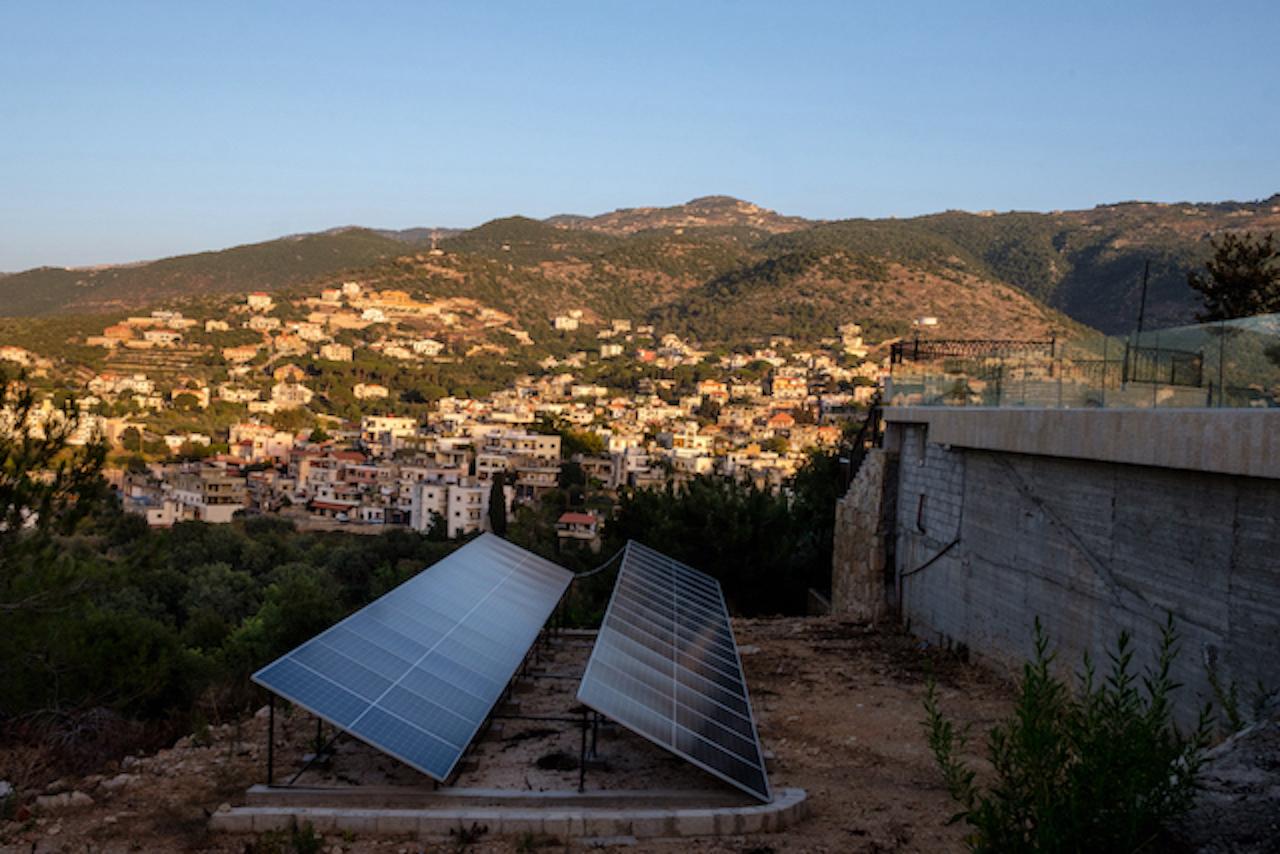
Villa owners can afford the cost and space it takes to install good solar systems. Akkar, Lebanon. September 30, 2022. (Rita Kabalan/The Public Source)
Customers with lower budgets are ending up with the worst systems, according to Obeid. They are purchasing the systems they can afford, no questions asked, and will eventually have to pay more to maintain the bad systems being installed. “You cannot expect a consumer to get a degree in electrical engineering in order to install a solar system,” she says. “Some people are literally throwing their money away.”
Lower-income households can also have a harder time installing systems adequately because of space restrictions. Osman tells us that renters whose landlords won’t allow them to use the roof space end up with panels precariously hanging off windows and balconies — not only less efficient in catching the sun’s rays, but also more likely to break.
The Looming Solar Waste Crisis
Solar energy systems are not immortal. Their efficacy degrades over time, and they eventually need to be disposed of. The end of a solar system’s lifespan is when another set of problems begins.
Solar “kits,” as solar energy systems are known, are made up of solar panels, a battery bank, a power inverter, cables, and mounting hardware. A solar panel is essentially an “electronic sandwich”: a thin layer of crystalline silicon cells (known as photovoltaic (PV) cells) that convert sunlight to electricity, protected on both sides by sheets of polymers and glass, and all held together in an aluminum frame. A junction box on the back of solar panels has the copper wiring that channels electricity away as it is generated.
The natural lifespan of a panel varies widely, from five years for the cheapest to over 25 for premium quality. But panels also die from unnatural causes, like when they are pounded by falling debris, picked up by stormy winds — mostly due to improper installation — or become the resting place of stray bullets amid celebrations of Brevet exam results in Lebanon (or in Tucson, Arizona).
Battery life spans also vary depending on type, from a few months for some gel batteries to 10 years for lithium batteries. Lead-acid batteries — the most commonly used in Lebanon — last between three to four years, assuming they are new and installed properly.
The eventual death of solar energy systems means the world is facing a solar waste glut. By 2050, up to 78 million metric tons of solar panels will have reached the end of their life, and the world will be generating 6 million metric tons of new solar electronic waste annually, estimates IRENA.
Yet IRENA could be severely undercounting, say scholars. IRENA based its numbers on current lifespans. But as the cost of new panels keeps decreasing, the technology keeps improving, and solar companies invite their customers to upgrade, consumers in higher-income countries will be likely to replace their panels much sooner than the current average lifespan. “The sheer volume of discarded panels will soon pose a risk of existentially damaging proportions,” warns one study.
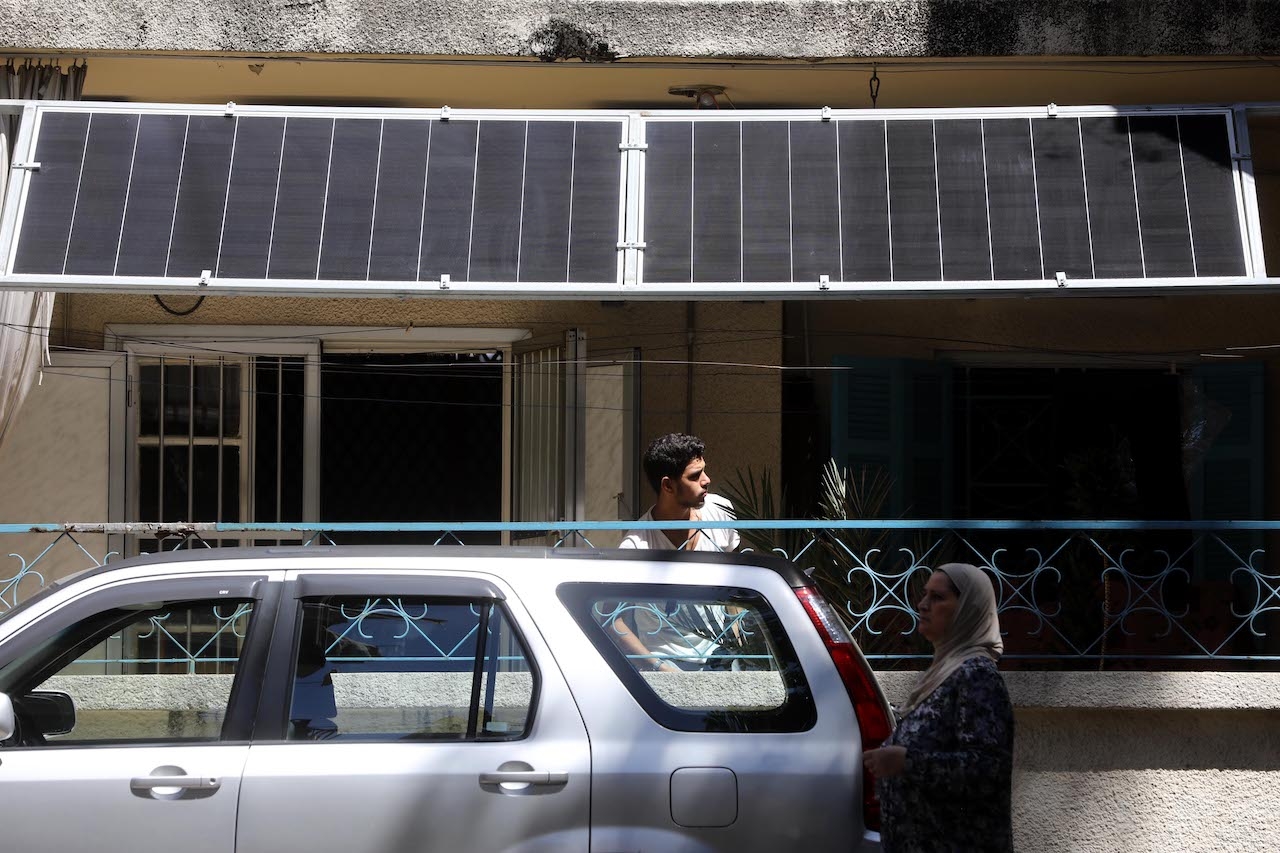
Lack of rooftop space and neighborly disputes over shared space, especially in urban areas, are pushing people to install panels on balconies, windows, and sidewalks. Engineers warn that these installations are less efficient and more likely to break. Barbir, Beirut, Lebanon. August 25, 2022. (Marwan Tahtah/The Public Source)
Just how soon the waste crisis is coming depends on where you are in the world. Analysts in the United States and Europe talk about a waste problem 20 to 30 years from now, making the point that there is time to put in place recycling schemes. But the timing looks very different in developing countries, where weak trade positions combined with more lax domestic regulations make the problem much more imminent.
In Lebanon, several factors are coming together to create the perfect storm of solar waste as early as five to seven years from now.
For one, the country has become “a dumpster” for low-quality solar products, in Obeid’s words. Desperate for cheaper prices because of the currency crisis, customers are willing to take practically any product on the market. And importers, facing acute dollar shortages, are pressuring exporters to cut corners on equipment quality to lower prices.
Khalil Saghir has been working as an engineer in solar power for 18 years. He is horrified by some of the products being imported, like the lead-acid batteries from India. Saghir tells us that some batteries are made with recycled lead where the weight is not accurate, while others are already worn out, meaning they will not last the three to four years of new ones.
Ismail, the importer, gets emails from Chinese suppliers asking him what fake brand or logo he wants on the panels, offering a list of available names.
Inverters are another problem. They are small electrical devices, the size of a power box, that convert the variable direct current (DC) output of a photovoltaic solar panel into an alternating current (AC) that can be used in electrical networks. “Inverters are supposed to last 10 years,” says Obeid, “but I know people changing their inverters every year.” According to Saghir, inverters are failing either because they are not being programmed right during installation, or because the cheaper ones being imported are missing essential components like filters.
As for the panels themselves, the problems run the gamut: Some come with tiny cracks that are invisible to the eye but make them much less efficient. Others are entirely counterfeit. “Some panels have microcracks in them from the factory,” says Saghir, “so they put them aside and sell them for cheaper to third world countries.” Others have them because of accidents during transport. Panels with microcracks will work, but be much less efficient, and they are more prone to overheating, which can lead to fires. Engineers can identify microcracks by inspecting the voltage of the panel, or using infrared cameras to test that the temperature is constant across the structure, but according to Saghir this is not a widespread practice in Lebanon.
And then we come to “fake” panels — panels that do not meet international standards and specifications, but fake the certificates and put the logos of more reputable brands that do meet these standards. Many of the installers, buyers, and energy experts we spoke to had come across this type of panel or seen photoshopped fake certificates. “Some people go and buy the unpopular brand for cheaper prices and put stickers of the famous brands,” says Saghir. Ismail, the importer, gets emails from Chinese suppliers asking him what fake brand or logo he wants on the panels, offering a list of available names.
China supplies 80 percent of the solar panel market, so the quality issue is “not a ‘made in China’ problem,” says Obeid. “There are top-notch products and bad products coming from China. The problem is that in Lebanon we are not checking the supplier, not testing, and to top it off, we have faulty installations.”
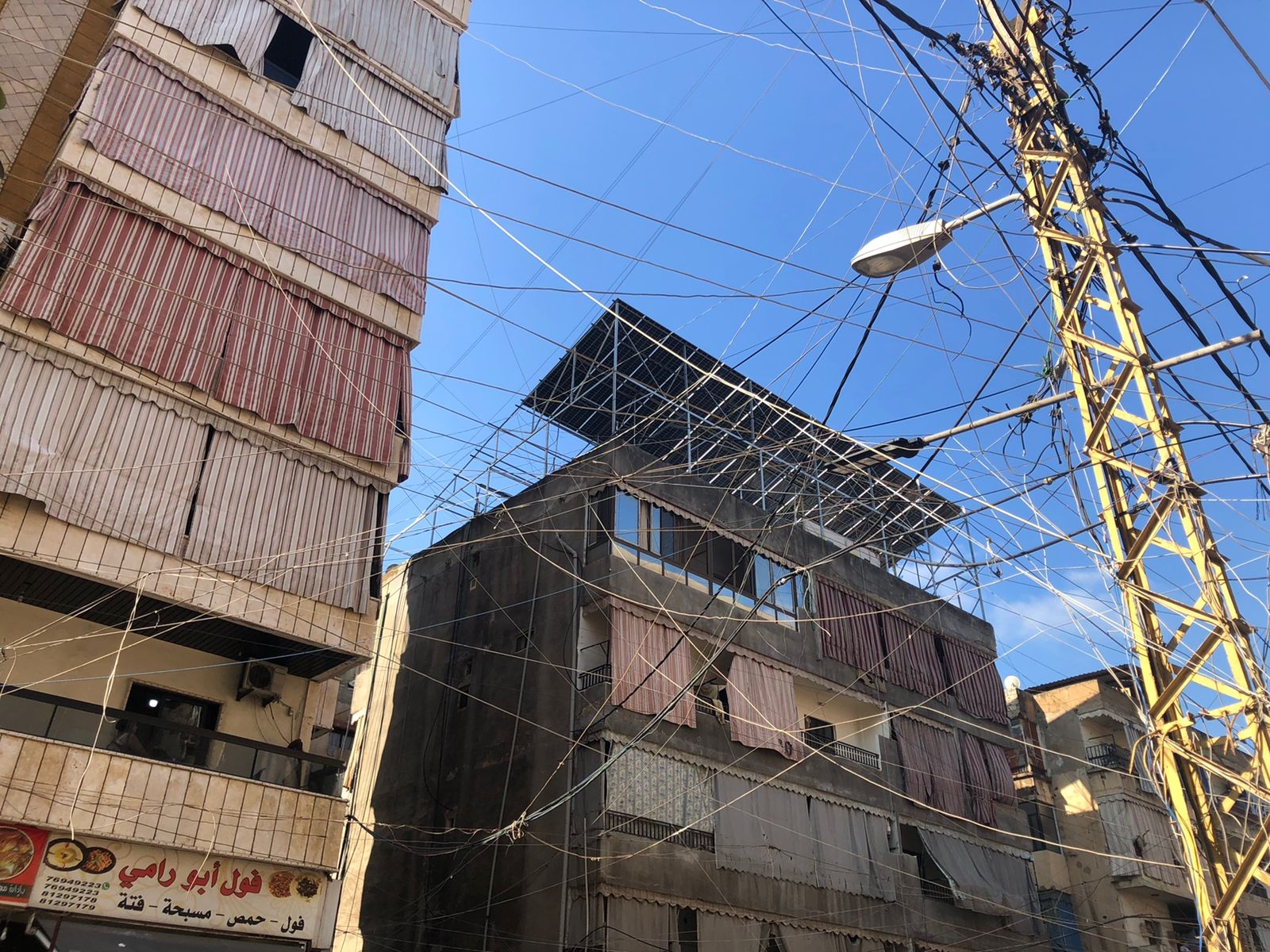
Behind an electric jungle of entangled wires, solar panels sit atop a building at the entrance of Shatila camp. Shatila, Lebanon. September 17, 2022. (Yara El Murr/The Public Source)
Faulty installations are another reason the waste crisis will hit Lebanon sooner than later. One concern is with the basic fixtures. With rooftops already crowded by water tanks and generators, people are installing panels on balconies, windows, and even sidewalks. Installers are not taking into account the wind load, says Reine Bou Khzam, an engineer at Dawtec, one of 43 solar companies officially recognized by the Ministry of Energy. “In the next storm, half the PV panels are going to fall,” she says. Other bad installations use indoor wiring that cannot withstand the weather, or fail to ground the solar system so that excess electricity has the most effective and safest route back to the ground — particularly dangerous during storms, if panels happen to be struck by lightning. “This is what happens when people hire a plumber or grocer to install solar,” says Saghir.
Bad products and worst installations threaten to create a solar waste problem for Lebanon much sooner than the 25–30 years that premium solar panels are supposed to last. We ask Obeid just how soon Lebanon could face a solar waste glut. “Most consumers are going to find systems performing well… at first,” she says. “But give it a year or two. People do not understand what is about to happen. Because of the complete absence of regulations and institutions, we have around five years.”
The Toxicity of Solar Waste
Solar waste is so worrisome because it is toxic. Photovoltaic panels, like other electronic waste (e-waste), contain potentially dangerous materials for public health and the environment, including silicon tetrachloride, selenium, cadmium, and sulfur hexafluoride — a potent greenhouse gas.
What to do with dead panels is an uncomfortable question for a global industry where recycling remains woefully inadequate, for two reasons: because its current cost exceeds the value of the material recovered, and because governments, with a few exceptions, are not mandating recycling. Globally, only 17.4 percent of e-waste is collected and recycled; the fate of the remaining 82.6 percent is “unknown,” according to a UN 2020 report. We do know, however, that solar panels are being dumped into regular landfills around the world. Once they break, their heavy metal contents leach into the soil.
When Lebanon’s solar panels are no longer useful, we can assume they are going to end up being thrown in landfills, says Ali Taha, researcher at the Lebanese Center for Policy Studies, “because we don’t have any recycling value chain for panels.” Only 0.2 percent of all e-waste in the country is formally collected and dismantled, the rest ends up in landfills, scrapyards, or in the more than 940 open dumps across the country — none of which are designed for this type of waste.
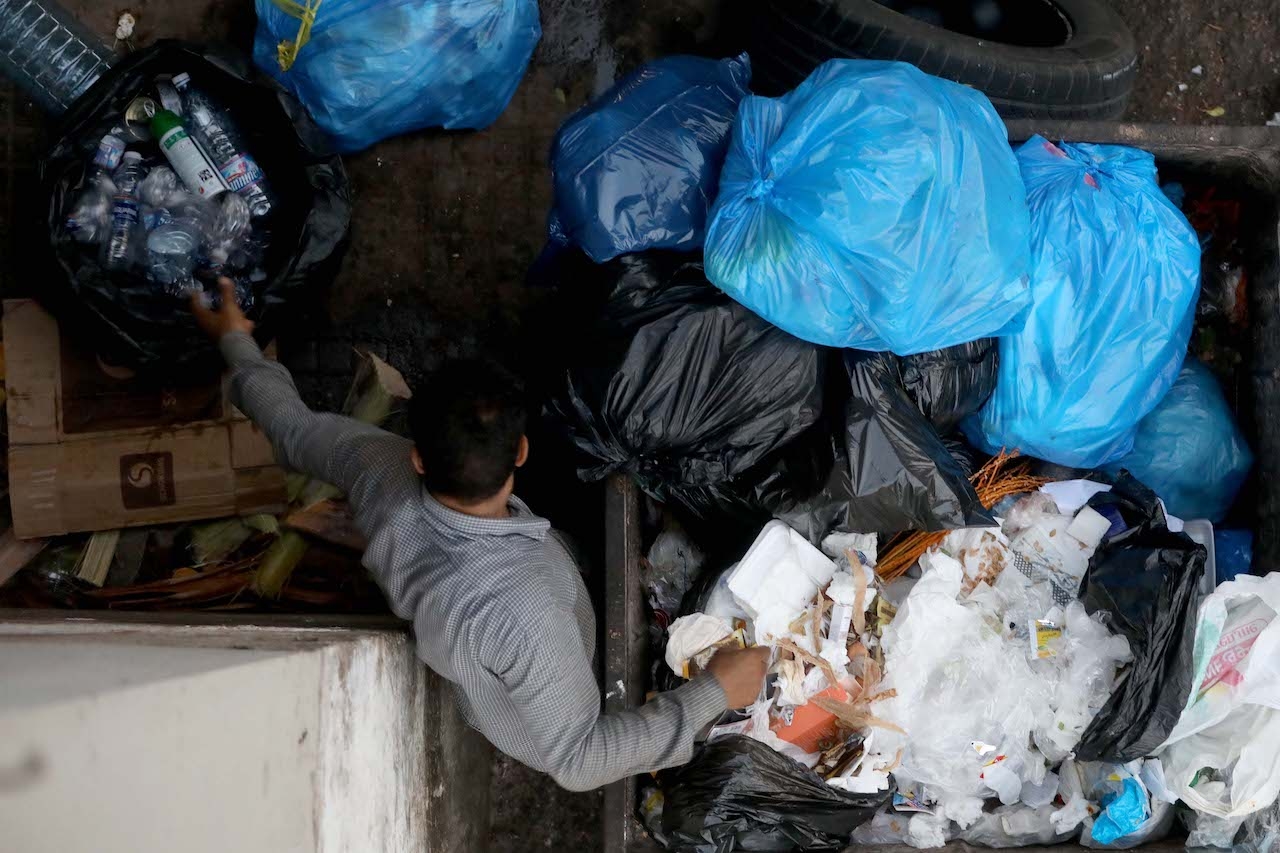
A waste picker sorts through a garbage bin to collect plastic bottles to be recycled. Hamra, Lebanon. September 26, 2022. (Marwan Tahtah/The Public Source)
Heavy metals in e-waste end up in the leachate of landfills, becoming an environmental hazard if not properly treated, says Samar Khalil, environmental management specialist and member of the Waste Management Coalition. In open dumps, toxins reach the soil, surface, and groundwater directly. They can also end up in the air: open dumps across the country are also burned on a regular basis, often directly adjacent to homes, disproportionately affecting the health of lower income households. Ultimately, says Khalil, these heavy metals “will be accumulating in soil and groundwater, and in our bodies.” Exposure to heavy metals, whether through ingestion or inhalation from open burning of waste, can damage the central nervous system and internal organs; it can cause reproductive health problems, cancer and genetic mutations.
Batteries, on the other hand, are considered hazardous waste because they contain lead, mercury, cadmium, nickel, sulfuric acid, and other dangerous materials. Lithium batteries, which are growing in numbers in Lebanon, are particularly worrisome. “They are extremely dangerous, very volatile — they are like bombs,” says Gaby Kassab, CEO of Ecoserv, a Lebanese e-waste company. “If they are exposed to heat, they will explode.”
There are no lithium recycling facilities in Lebanon. The only plan in the works is for Ecoserv to export lithium batteries to Europe through an agreement with the European Union, under the framework of the Basel Convention that allows countries unable to handle hazardous waste to export it to those that can. When we ask about the business plan that can sustain this effort, CEO Gaby Kassab admits they are still working out how to incentivize anyone with these batteries to bring them to Ecoserv.
It is hard to be optimistic when recycling companies around the world have shut down because they cannot cover costs when grants run out. The solution, say environmental activists and now even some governments, is to require manufacturers — those who actually profit from the sale of new technologies — to collect end-of-life products and recycle them, or to pay for the cost of recycling.
Unlike lithium, lead-acid batteries, the most common type in Lebanon, power a competitive recycling market. More than 90 percent of the weight of lead-acid batteries can be recycled. Because the recovered lead is sold in dollars by weight, mostly abroad, the field is crowded by a few large factories, many small shops, and a large informal sector. Some of these batteries are also smuggled into Syria.
Many of Lebanon’s waste workers are children, often economic or forced migrants, and even more vulnerable to the long-term health dangers of hazardous waste than adults. They are on the frontlines of waste work, sorting and breaking down products by hand. When Lebanon’s solar boom turns into a solar waste glut, they’ll be the ones who pay with their health.
Heavy lead exposure can cause kidney, liver, and lung disease, as well as brain damage and other health problems. According to Elie Romanos at the NGO Arcenciel, which is conducting studies of lead recycling in Lebanon, national lead smelting industries do not comply with environmental standards: workers recovering lead often dump acid on the ground, rather than collecting it in special barrels, which pollutes the soil and water with lead. But they are still much better than the alternative: haphazard open burning of batteries by the informal waste workers who have long been essential to processing, transporting, and selling trash in Lebanon.
Many of Lebanon’s waste workers are children, often economic or forced migrants, and even more vulnerable to the long-term health dangers of hazardous waste than adults. They are on the frontlines of waste work, sorting and breaking down products by hand. When Lebanon’s solar boom turns into a solar waste glut, they’ll be the ones who pay with their health. “I have seen different categories of hazardous waste enter into the small scrapyard where mostly underage waste pickers work,” says Elizabeth Saleh, an anthropologist who conducted a four-year ethnographic study of a group of young boys as they grew up at a small Beirut scrapyard. She is most concerned about lead-acid batteries. “They leak sulphuric acid and lead,” she says. “One burns; the other is poisonous and can result in brain and liver damage.”
Sharing the Sun
Given that the “solar is dirty” narrative is being used by the anti-renewables camp worldwide, it bears repeating that renewable energy is essential for climate mitigation as well as reducing air pollution. But like all energy systems, “you’re solving one problem and creating another one,” says Samar Khalil.
There are alternatives to the atomized way solar energy has landed in Lebanon that would make it more accessible and less wasteful. Around the world, people are setting up cooperatives and “energy communities” that share solar systems so that use is optimized. For climate justice activists, decentralized, democratized, and community-based renewable energy is the way to address both climate and economic crisis — especially in contexts like Lebanon where the state utility company is captured.
But Lebanon’s politicians and the moteur mafias who control the micro-grids are making it harder for solar solutions to move beyond the every-household-for-itself model. The current energy law allows households to install solar systems for personal use of up to 1.5 megawatts, but bans any sharing or selling. Neighbors, institutions, municipalities, cooperatives, or any other collectivities, cannot share electricity on micro-grids. The only legal alternative to off-grid, personal use is net-metering through Électricité du Liban (EDL), whereby households would sell their excess power back to the grid. With EDL providing close to no electricity these days, net-metering in Lebanon is purely theoretical.
Small, decentralized experiments are popping up in villages around Lebanon. But because they are illegal, they have a hard time scaling up or spreading. A draft Distributed Renewable Energy law that would allow for micro-grid sharing of solar energy without EDL’s interference has been stuck in a subcommittee in parliament, with proponents worried it is being gutted to no longer allow for that possibility.
Christina Abi Haidar, a legal consultant involved in drafting the law, walks us through how she worked on the law for three years, relying on regional case comparisons and in close consultation with EDL staff to ensure technical feasibility, how they sent the draft to the minister of energy and water, how he passed it to the council of ministers — only to have him suddenly withdraw the draft and rework it. The amended version, which is not yet public, would give the minister himself sole power to authorize or reject any decentralization schemes, effectively politicizing and monopolizing the process. “We have the case of a political party that has controlled electricity for decades, which thinks it’s going to control the ministry forever, and that is using this as another entry point to control the sector,” says Abi Haidar.
As it derails the process that could encourage community control of solar energy, the government has instituted minor and seemingly irrelevant regulations: a ban on importing used solar panels, and a requirement that households certify their installations with a letter from the ministry of interior and the ministry of energy and water. Both ministries are supposedly inspecting solar installations to ensure public safety and address neighborly disputes over use of common space. We contacted the Lebanese Center for Energy Conservation (LCEC), an entity affiliated to the ministry of energy and water, to find out more. Sorina Mortada, a technical consultant at LCEC, said they do keep records on applications, but could not share the number.
Asking about this process elicited either laughter or indifference among most of our interviewees. Wassim Osman says a few of his clients have asked him to wait while they procure the official letter. But he has yet to hear of any actual inspections. “Sounds like another way for officials to try to take a cut, don’t you think?” he says, with a chuckle.
